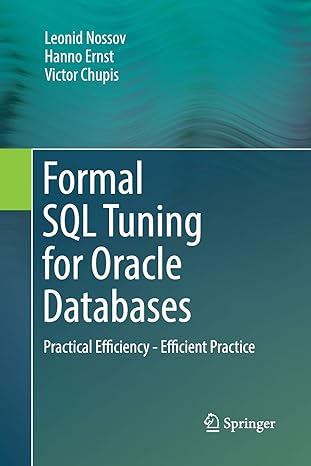Answered step by step
Verified Expert Solution
Question
1 Approved Answer
Answer the following questions 1 ) Draw a binary balanced search tree without a balancing rotation mechanism for the following values, and explain your strategy
Answer the following questions
Draw a binary balanced search tree without a balancing rotation mechanism for the following values, and explain your strategy to build such sorted n number of elements:
Draw a new binary search tree that results from adding the following integers Assume our simple implementation with no balancing mechanism.
Starting with the result from Exercise draw the tree that results from removing again using our simple implementation with no balancing mechanism.
Draw a new AVL Balanced Tree that results from adding the following integers and show each iteration.
Starting with the resulting tree from Exercise draw the tree that results from performing a remove the root operation and show each iteration according to AVLTree remove process remove root only one time
Write a method to take a BinayTreeNode input root for level order, preOrder, postOrder, and inOrder methods.
Write a method to take a BinayTreeNode input root and determine whether the given tree is Binary Search Tree
Suppose you are given the following set of keys to insert into a hash table that holds exactly values. Which index positions would those keys map to according to chaining?
Suppose you are given the following set of keys to insert into a hash table that holds exactly values. Which index positions would those keys map to according to linear probing?
Suppose you are given the following set of keys to insert into a hash table that holds exactly values. Which index positions would those keys map to according to quadratic probing?
Suppose you are given the following set of keys to insert into a hash table that holds exactly values. Which index positions would those keys map to according to h x i x mod mod
Draw the minHeap that results from adding the following integers
Starting with the resulting tree from Exercise draw the minHeap that results from performing a remove root operation.
Repeat Exercise by using the same numbers to create a new maxHeap and remove the root from the maxHeap.
Draw the undirected graph that is represented by the following:
vertices:
edges:
Write a matrix representation of the Exercise graph.
Is the graph from Exercise connected? Is it complete?
List all of the cycles in the graph from Exercise
Use the resulting graph of Exercise Starting from vertex and apply breadthfirst search traversal by visiting the vertex according to increasing order.
Use the resulting graph of Exercise Starting from vertex and apply depthfirst search traversal by visiting the vertex according to increasing order.
Draw a spanning tree for the graph of Exercise
Using the same data from Exercise draw the resulting directed graph.
Is the directed graph of Exercise connected? Is it complete?
Step by Step Solution
There are 3 Steps involved in it
Step: 1

Get Instant Access to Expert-Tailored Solutions
See step-by-step solutions with expert insights and AI powered tools for academic success
Step: 2

Step: 3

Ace Your Homework with AI
Get the answers you need in no time with our AI-driven, step-by-step assistance
Get Started


